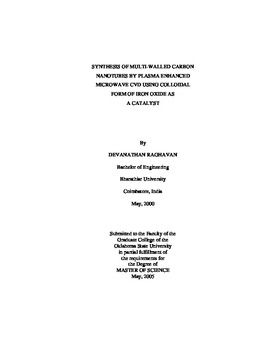| dc.contributor.advisor | Komanduri, Ranga | |
| dc.contributor.author | Raghavan, Devanathan | |
| dc.date.accessioned | 2014-04-17T19:53:41Z | |
| dc.date.available | 2014-04-17T19:53:41Z | |
| dc.date.issued | 2005-05-01 | |
| dc.identifier.uri | https://hdl.handle.net/11244/10033 | |
| dc.description.abstract | Carbon nanotubes (CNTs) were discovered in 1991 by Sumio Iijima of NEC Corporation, Japan. They are rolled up sheets of graphene and have structure resembling that of an elongated fullerene molecule. Because of their potential in scientific and technological applications in various fields, they are investigated extensively in the past decade and the field is still active. Some of the applications of carbon nanotubes include advanced nanocomposites, conducting polymers, tips for scanning probe microscopy, flat panel displays, hydrogen storage, MEMS, NEMS, nanoelectronics, and nanocircuits. They posses excellent mechanical, thermal, optical, and electronic properties. In this investigation plasma enhanced microwave CVD technique is used to synthesize carbon nanotubes using colloidal form of iron oxide as a catalyst. Various process parameters and experimental conditions are varied to obtain vertically aligned nanotubes with fewer impurities and superior yield. The process parameters varied include the importance of plasma pretreatment and its variation, growth time, catalyst concentration, method of catalyst coating, chamber pressure and methane flow rate. SEM, TEM, AFM, EDS and -Raman spectroscopy are used to characterize the grown multi-walled carbon nanotubes. Plasma enhanced microwave CVD was found to be an effective means for synthesizing vertically aligned nanotubes with superior yield. Plasma pretreatment time is found to be essential for the nanotubes growth as no growth was found with no pretreatment. A pretreatment time of 10 mins was found to be optimum. Smearing of the catalyst was found to yield better aligned nanotubes. The variation of the growth time revealed that 10 mins of growth is optimum and yield tubes with better alignment. The vertical alignment of the tube was found to increase with increase in chamber pressure and 20 torr was found to be optimum pressure for better vertical alignment and greater nucleation density. The flow rate of methane was varied and the nanotubes obtained are aligned vertically. Also, as the flow rate of methane increases the amount of impurities in the central deposit region was found to decrease. TEM and -Raman Spectroscopy indicates that the grown nanotubes are multi-walled. | |
| dc.format | application/pdf | |
| dc.language | en_US | |
| dc.publisher | Oklahoma State University | |
| dc.rights | Copyright is held by the author who has granted the Oklahoma State University Library the non-exclusive right to share this material in its institutional repository. Contact Digital Library Services at lib-dls@okstate.edu or 405-744-9161 for the permission policy on the use, reproduction or distribution of this material. | |
| dc.title | Synthesis of Multi-walled Carbon Nanotubes by Plasma Enhanced Microwave Cvd Using Colloidal Form of Iron Oxide as a Catalyst | |
| dc.type | text | |
| dc.contributor.committeeMember | Roy, Samit | |
| dc.contributor.committeeMember | Lu, Hongbing | |
| osu.filename | Raghavan_okstate_0664M_1349.pdf | |
| osu.college | Engineering, Architecture, and Technology | |
| osu.accesstype | Open Access | |
| dc.description.department | Mechanical & Aerospace Engineering | |
| dc.type.genre | Thesis | |
| dc.subject.keywords | carbon nanotubes | |
| dc.subject.keywords | cvd | |
| dc.subject.keywords | cnt | |
| dc.subject.keywords | iron oxide | |
| dc.subject.keywords | synthesis techniques | |
